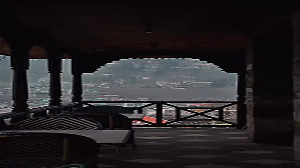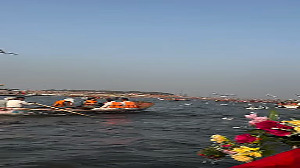On Monday, July 31, Union Science and Technology Minister Kapil Sibal told Parliament that the government has set up a ministry of earth sciences.
The creation of the new ministry, which Sibal holds additional charge of, is significant as it will change the role and functioning of the India Meteorological Department, which is responsible for the nation's weather forecasts.
The new ministry has been formed by merging the IMD with the ministry of ocean development. The IMD was earlier associated with the Department of Science and Technology in the ministry of science and technology.
'We have created the new ministry to bring ocean and atmospheric observations together and also generate better weather forecasts,' Sibal told Parliament.
Officials in the Department of Science and Technology pointed out that the decision to set up the ministry was long-pending.
"It will now speed up the process of modernisation of weather forecasts in India," a senior official told Rediff.com
The current plan under the new ministry, the official continued, is not only to significantly improve the density of the observational network but also to technologically upgrade it through installation of equipment like Doppler Weather Radar, Automatic Rain Gauges, wing Profilers, etc.
The official said the Indian government has far lacked in the area of developing a suitable model for weather systems.
"Our region often suddenly displays erratic behaviour as compared to the extra tropical regions, which are characterised by weather systems displaying systematic development and movement. Hence weather forecasting in our country is different and more difficult," he pointed out.
"We hope the IMD will now have a well equipped, state-of-the-art weather forecasting system by 2008," he added.
Officials said the structure of the new ministry would be on the lines of the Departments of Space and Atomic Energy.
The Earth Commission will be similar to the Space Commission and the Atomic Energy Commission. The Earth Sciences Organisation will be on the lines of the Indian Space Research Organisation.
An empowered body consisting of representatives of key ministries, the Earth Commission will have powers of the central government, both administrative and financial, to carry out the ministry's work.
The secretary of the ministry will be the chairperson of the Commission, and its members will include the principal secretary to the prime minister, the home secretary, the expenditure secretary and the member secretary of the Planning Commission.
Along with the creation of the new ministry, the government has signed a memorandum of understanding with METEO France, the French Meteorological Agency, to jointly work on modelling and strengthening the information technology infrastructure to improve the IMD's capabilities.
Over the years, the IMD has been dogged by forecast problems because not enough investment has been made to upgrade equipment and to boost the observation network.
In 2002, Indian meteorologists burned their fingers when they predicted that a cyclone would hit along the Chennai-Andhra Pradesh-Orissa coastline. The cyclone made its way to Bangladesh and wreaked havoc there.
In 2003, adequate rainfall in the July monsoon season was predicted. The severe drought that hit across north Indian states that year considerably upset the country's water supply and agricultural production.
This forced the IMD to resort to a new forecast method two years ago.
It has now classified the probability of monsoon rainfall for the country as a whole into five categories: Drought (less than 90 per cent of long period average), below normal (90 per cent to 97 per cent), near normal (98 per cent to 102 per cent), above normal (103 per cent to 110 per cent) and excess (more than 110 per cent).
Though the new method of weather forecasts has reduced inaccuracies, the department remains hamstrung without state-of-the-art gadgets.
"Now that we have decided to tie up with the French meteorological agency, our forecasting equipment will undergo a facelift," a senior IMD official hoped.
The Indian Space Research Organisation has also embarked on a few initiatives to make the meteorologists' analytical and forecasts methods easier.
ISRO is planning a joint satellite project called MeghaTropiques with French collaboration for an exclusive meteorology satellite. It will be launched later this year.






 © 2025
© 2025